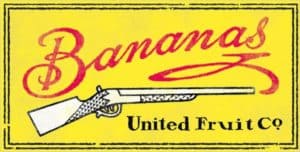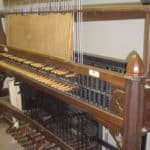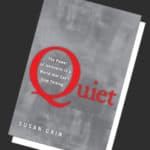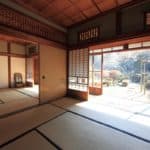
1
MarGetting to Know the Forbes Mansion
 The Town of Norwood’s recent real estate purchase crowns the top of a hill at the end of a long curving road without a street name. The tree-lined approach reveals a stately Georgian Revival manor with a well-preserved exterior and sprawling grounds ideal for summer garden parties and croquet. Buying the property did not escape controversy, but officially owning it now warrants a glimpse into the mansion’s history.
The Town of Norwood’s recent real estate purchase crowns the top of a hill at the end of a long curving road without a street name. The tree-lined approach reveals a stately Georgian Revival manor with a well-preserved exterior and sprawling grounds ideal for summer garden parties and croquet. Buying the property did not escape controversy, but officially owning it now warrants a glimpse into the mansion’s history.
According to Patricia Fanning’s Norwood: A History, W. Cameron Forbes’ home was built between 1914 and 1916, and the accompanying hundreds of acres of land included farms, greenhouses, a sawmill, an orchard and a cider mill. Many locals worked on the estate, and Norwood residents enjoyed activities such as camping and hunting on the grounds. Mr. Forbes made one important alteration though: the establishment of a proper polo field to accommodate his beloved pastime. Fanning notes that the house contained a “pony parlor” indoors for the horses. A tunnel, now sealed up with stone, led the animals out to the fields in grand fashion. Forbes’ favorite pony rests in peace buried beside the mansion, with a plaque in his honor.
When Forbes served as Governor-General of the Philippines, he shipped exotic hardwoods home, detailing the mansion with walls, ceilings and doors made from rare and beautiful varieties of wood. Unfortunately this preceded today’s regulations and environmental protections, and many of the trees he used, such as molave and tindalo, have since gained the status of endangered or threatened species. Old photos show the rooms adorned with hardwood furniture, artwork, taxidermy, and curios from abroad on display under bell jars. Today almost none of this remains in situ.
In the early 1950s before his death, W. Cameron Forbes donated his estate to Harvard University, which in quick turnaround sold it to the United Fruit Company. The company maintained the grandeur of the mansion, while making adjustments for adding greenhouses, growing bananas, and studying insects. According to Fanning, Norwood once boasted “the largest banana research facility outside the tropics.” While scientists from the Boston area’s top universities labored at building a better banana, the parent company was up to more nefarious business abroad.
The book, Bananas: How the United Fruit Company Shaped the World, by Peter Chapman, describes the company’s historical alignment with the U.S. government and frequent role in dictating the fate of banana-growing countries in Latin America. United Fruit supplied ships for the Bay of Pigs invasion. For decades it took advantage of cheap labor abroad and mistreated poor workers, paying a pittance, often in company scrip instead of the country’s currency.
Ecologically, much of United Fruit’s acclaimed banana research ultimately backfired. The company, with help from the Forbes Mansion research team, made the fruit suitable for mass production. They experimented with pesticides, fungicides, and fertilizers until plantations throughout Latin America were succumbing to disease, and disease-prevention made the industry increasingly less profitable. Back in the U.S. the scientists attempted to diversify the company, experimenting with dehydration methods and research on other fruits, but the United Fruit banana monopoly dwindled.
According to Bryant Franklin Tolles, Jr.’s book, Norwood: The Centennial History of a Massachusetts Town, Polaroid purchased the Forbes estate in 1967 and soon after constructed a camera manufacturing plant on the grounds. The company took care to protect the natural environment and landscaping of the grounds where polo ponies once competed, while using the house for corporate offices. In the 1990’s when digital cameras came into popularity and demand for “Polarioids” declined, Putnam Investments purchased the mansion and its land for offices and trainings, as explained by Fanning.
I had the privilege of visiting the Forbes Mansion when a few of the Library’s staff received an invitation to see and review the house’s library. In the home that originally had 30 rooms, the Library alone remains largely unchanged. The two-floor balconied room, lined floor to ceiling with bookshelves on all sides provides a small glimpse into what the mansion looked like originally. We did not see many books from Forbes’ time, about polo or the Philippines, or books from the United Fruit era, on agriculture and entomology. While the shelves look beautiful filled with reading material, the books themselves represent a more recent era.
The rest of the house has uniform neutral walls and carpeting, wiring for computers and audiovisual equipment, and almost no trace of the old hardwood or artwork that once graced the mansion. We don’t know whether United Fruit, Polaroid, or Putnam bear responsibility for “modernizing” the house and decreasing its character, but likely all three made changes and renovations over time.
A Boston Globe article from the 1950s indicates that Harvard offered to sell the mansion to the Town of Norwood before United Fruit bought it, but the town declined, due to the expenses anticipated for upkeep and maintenance. Now, decades later, we do own the Forbes Mansion, and what the Town will do with it remains up in the air, but my one hope is that the Library remains intact.
Lydia Sampson is the Technical Services department head at the Morrill Memorial Library in Norwood, Massachusetts. Read Lydia’s column in the March 1, 2018 edition of the Norwood Transcript and Bulletin.








